The Art and Practice of Hawking E B Mitchell Ct Branford Co Newton Mass
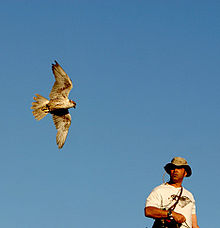
![]()
Flying a Saker Falcon
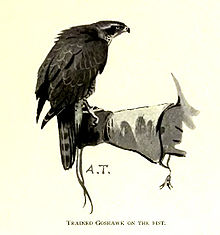
![]()
A Goshawk
Falconry is "the taking of wild quarry in its natural land and habitat by means of a trained raptor". [i] There are two traditional terms used to describe a person involved in falconry: a falconer flies a falcon; an austringer (German language origin) flies a militarist (Accipiter and some buteos and similar) or an eagle (Aquila or like). In modern falconry the Carmine-tailed Militarist (Buteo jamaicensis) and the Harris militarist are often used. The words "hawking" and "hawker" have become used so much to mean niggling traveling traders, that the terms "falconer" and "falconry" now apply to all apply of trained birds of prey to grab game. In early English falconry literature, the word "falcon" referred to a female falcon just, while the word "hawk" or "hawke" referred to a female hawk. A male hawk or falcon was referred to as a "tiercel" (sometimes spelled "tercel") as it was roughly one tertiary less than the female in size. [2] [iii] Many contemporary practitioners notwithstanding utilize these words in their original pregnant. The practice of hunting a trained falconry bird is besides called "hawking" or "gamehawking".
Contents
- 1 History
- one.1 Timeline
- one.2 The Book of St Albans
- 1.3 Falconry in U.k. in 1973
- two Birds used in contemporary falconry
- 2.1 Harris's Hawk (Parabuteo unicinctus)
- 2.2 Soaring hawks and the Common Buzzard (Buteo)
- 2.iii Truthful hawks (Accipiter)
- 2.four Falcons (Falco)
- two.v Booted eagles (Aquila)
- ii.6 Owls (Strigidae)
- 2.7 Osprey (Pandion)
- 2.8 Sea eagles (Haliaëtus)
- 2.9 Species for beginners
- 3 Husbandry, training, and equipment
- 4 Falconry around the world
- 5 Clubs and organizations
- half dozen Captive breeding and conservation
- seven Hybrid falcons
- 8 Artificial selection and domestication
- 9 Escaped falconry birds
- x Regulations in Great United kingdom of great britain and northern ireland
- 11 Regulations in the U.Due south
- 12 Falconry today
- thirteen Literature and film
- fourteen English language idioms derived from falconry
- 15 Meet also
- 16 References
- 17 Further reading
- 18 External links
History
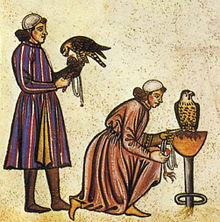
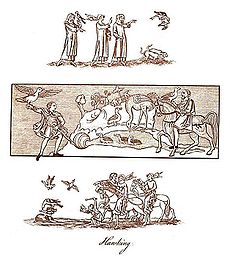
![]()
Three panels depicting Hawking in England from various time periods, as reprinted in Joseph Strutt's 1801 volume, The sports and pastimes of the people of England from the earliest period. The middle panel is from a Saxon manuscript dated to the late 900s - early 1000s, as of 1801 held in the "Cotton wool Library", showing a Saxon nobleman and his falconer. The tiptop and bottom panels are drawings from a manuscript held, every bit of 1801, in the "Regal Library" dating from early 14th century showing parties of both sexes hawking past the waterside; the falconer is frightening the fowl to make them rise and the hawk is in the act of seizing upon one of them. [4]
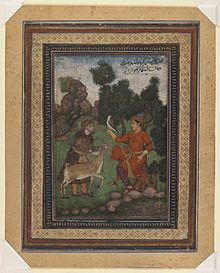
![]()
Brooklyn Museum - A Falconer and a Gamekeeperca. 1600
Evidence suggests that the art of falconry may have begun in Mesopotamia, or in Mongolia and Communist china, with the earliest accounts dating to approximately 2000 BC. Falcon was a symbolic bird of ancient Mongol tribes. At that place is some disagreement about whether such early accounts document the practise of falconry (from The Epic of Gilgamesh and others) or are misinterpreted depictions of humans with birds of prey. [v] [6] Falconry was probably introduced to Europe around Advert 400, when the Huns and Alans invaded from the East. Frederick II of Hohenstaufen (1194–1250) is more often than not acknowledged as the well-nigh significant wellspring of traditional falconry knowledge. He is believed to have obtained firsthand knowledge of Arabic falconry during wars in the region (between June 1228–June 1229). He obtained a copy of Moamyn'southward transmission on falconry and had it translated into Latin by Theodore of Antioch. Frederick II himself fabricated corrections to the translation in 1241 resulting in De Scientia Venandi per Aves. [vii] Male monarch Frederick 2 is most recognized for his falconry treatise, De arte venandi cum avibus ("The Art of Hunting with Birds"). Written himself toward the end of his life, information technology is widely accustomed as the first comprehensive book of falconry, but likewise notable in its contributions to ornithology and zoology. De arte venandi cum avibus incorporated a diverseness of scholarly traditions from e to westward, and is one of the earliest and most significant challenges to Aristotle's often flawed explanations of nature. [8]
Historically, falconry was a popular sport and condition symbol among the nobles of medieval Europe, the Middle E, and Mongolian Empire. Many historical illustrations left in Rashid al Din's "Compendium chronicles" book described heart centure's falconry with Mongol images. Falconry was largely restricted to the noble classes due to the prerequisite commitment of fourth dimension, money, and space. In art and in other aspects of culture such as literature, falconry remained a status symbol long after information technology was no longer popularly good. The historical significance of falconry within lower social classes may exist underrepresented in the archaeological record, due to a lack of surviving testify, specially from Altaic nomads and not-agrestal societies. Within nomadic societies similar the Bedouin, falconry was not practiced for recreation by noblemen. Instead, falcons were trapped and hunted on pocket-sized game during the winter months in order to supplement a very express diet. [9]
In the UK and parts of Europe, falconry probably reached its zenith in the 17th century, [2] [iii] only soon faded, specially in the late 18th and 19th centuries, every bit firearms became the tool of selection for hunting (this likely took identify throughout Europe and Asia in differing degrees). Falconry in the United kingdom had a resurgence in the late 19th, early 20th century during which time a number of falconry books were published. [10] This revival led to the introduction of falconry in Northward America in the early 1900s. Col R. Luff Meredith is recognized every bit the begetter of North American falconry. [11]
Throughout the 20th century, modern veterinary practices and the advent of radio telemetry (transmitters attached to gratuitous-flight birds) increased the average lifespan of falconry birds and immune falconers to pursue quarry and styles of flight that had previously resulted in the loss of their hawk or falcon.
Timeline
- 722-705 BC - An Assyrian bas-relief plant in the ruins at Khorsabad during the excavation of the palace of Sargon Ii (Sargon 2) has been claimed to draw falconry. In fact, it depicts an archer shooting at raptors and an attendant capturing a raptor. A. H. Layard's argument in his 1853 volume Discoveries in the Ruins of Nineveh and Babylon is "A falconer bearing a militarist on his wrist appeared to be represented in a bas-relief which I saw on my concluding visit to those ruins."
- 680 BC - Chinese records describe falconry. E. W. Jameson suggests that show of falconry in Japan surfaces.
- 355 Advertising - Japan-shoki, a largely mythical narrative, records hawking showtime arriving in Nippon equally of the 16th emperor Nintoku from Baekje, one of the Three Kingdoms of Korea.
- second-4th century - the Germanic tribe of the Goths learned falconry from the Sarmatians .
- 5th century - the son of Avitus, Roman Emperor 455-456, from the Celtic tribe of the Arverni who fought at the Battle of Chalons with the Goths against the Huns introduced falconry in Rome.
- 500 - a Roman floor mosaic depicts a falconer and his hawk hunting ducks.
- 8th and 9th century and continuing today - Falconry flourished in the Heart E.
- 818 - The Japanese Emperor Saga ordered someone to edit a falconry text named "Shinshuu Youkyou".
- 875 - Western Europe and Saxon England practiced falconry widely.
- 991 - The Battle of Maldon. A poem describing information technology says that before the boxing, the Anglo-Saxons' leader Byrhtnoth "let his tame militarist fly from his manus to the wood".
- c.1240s - The treatise of an Arab falconer, Moamyn, was translated into Latin by Principal Theodore of Antioch, at the court of Frederick II, it was called De Scientia Venandi per Aves and much copied.
- 1250 - Frederick II wrote in the final years of his life a treatise on "The Art of Hunting with Birds": De arte venandi cum avibus.
- 1390s - In his Libro de la caza de las aves, Castilian poet and chronicler Pero López de Ayala attempts to compile all the available correct cognition concerning falconry.
- 1486 -See the Boke of Saint Albans
- early on 16th century - Japanese warlord Asakura Norikage (1476-1555) succeeded in convict breeding of goshawks.
- 1600s - Dutch records of falconry; the Dutch town of Valkenswaard was almost entirely dependent on falconry for its economy.
- 1660s - Tsar Alexis of Russia writes a treatise which celebrates artful pleasures derived from falconry.
- 1801 - James Strutt of England writes, "the ladies not merely accompanied the gentlemen in pursuit of the diversion [falconry], merely frequently good it past themselves; and even excelled the men in knowledge and exercise of the art."
- 1934 - The first Usa falconry club, The Peregrine Lodge, is formed; it died out during Earth State of war 2
- 1941 - Falconer'due south Order of America formed
- 1961 - Falconer's Club of America defunct
- 1961 - Due north American Falconers Association (NAFA) formed
- 1970 - Peregrine Falcon listed as an Endangered Species in the U.S., due primarily to the use of DDT equally a pesticide (35 Federal Register 8495; June two, 1970).
- 1970 - The Peregrine Fund is founded, mostly past falconers, to conserve raptors, and focusing on Peregrines.
- 1972 - DDT banned in the U.Southward. (EPA press release - December 31, 1972) simply continues to exist used in Mexico and other nations.
- 1999 - Peregrine falcon removed from the Endangered Species listing in the United States, due to reports that at least 1,650 peregrine convenance pairs existed in the U.Due south. and Canada at that time. (64 Federal Annals 46541-558, August 25, 1999)
- 2003 - A population report by the USFWS shows peregrine falcon numbers climbing ever more apace, with well over 3000 pairs in North America
- 2006 - A population report by the USFWS shows peregrine falcon numbers yet climbing. (Federal Register circa September 2006)
- 2008 - USFWS rewrites falconry regulations well-nigh eliminating federal involvement. {Federal Register: October 8, 2008 (Volume 73, Number 196)}
The Book of St Albans
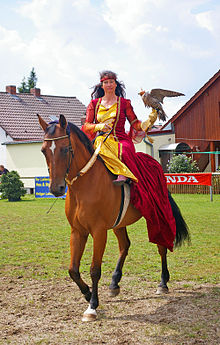
The often-quoted Book of St Albans or Boke of St Albans, first printed in 1486, often attributed to Dame Julia Berners, provides this hierarchy of hawks and the social ranks for which each bird was supposedly appropriate. The line numbers are non in the original.
- Emperor: The Hawkeye, Vulture, and Merloun
- Male monarch: The Ger Falcon and the Tercel of the Ger Falcon
- Prince: The Falcon Gentle and the Tercel Gentle
- Duke: The Falcon of the Loch
- Earl: The Falcon Peregrine
- Baron: The Bustard
- Knight: The Sacre and the Sacret
- Esquire: The Lanere and the Laneret
- Lady: The Marlyon
- Young man: The Hobby
- Yeoman: The Goshawk
- Poor Human: The Tercel
- Priest: The Sparrowhawk
- Holy Water Clerk: The Musket
- Knave or Servant: The Kestrel
This list, nevertheless, was mistaken in several respects.
- ane) Vultures are not used for falconry.
- 3) iv) five) These are usually said to be unlike names for the Peregrine Falcon. But there is an stance that renders four) as "rock falcon" = a peregrine from remote rocky areas, which would exist bigger and stronger than other peregrines. This could too refer to the Scottish Peregrine.
- 6) The bustard is not a bird of prey, merely a game species that was commonly hunted by falconers; this entry may have been a mistake for buzzard, or for busard which is French for "harrier"; but any of these would be a poor bargain for barons; some treat this entry as "bounder hawk", possibly meaning a hawk of unknown lineage, or a hawk that couldn't be identified.
- vii) eight) Sakers were imported from away and very expensive, and ordinary knights and squires would exist unlikely to have them. At that place are gimmicky records of lanners native to England.
- 10) xv) Hobbies and kestrels are historically considered to be of piffling utilise for serious falconry. (The French name for the Hobby is faucon hobereau, hobereau meaning local/country squire. That may be the source of the confusion.), however Male monarch Edward I of England sent a falconer to catch hobbies for his use. Kestrels are coming into their ain every bit worthy hunting birds, as modernistic falconers dedicate more time to their specific style of hunting. While not suitable for communicable game for the falconer's table, kestrels are certainly capable of catching enough quarry that they can exist fed on surplus kills through the molt.
- 12) There is an opinion [12] that, since the previous entry is the goshawk, this entry ("Ther is a Tercell. And that is for the powere [= poor] human being.") means a male person goshawk and that here "poor man" means not a labourer or beggar merely someone at the bottom end of the calibration of landowners.
It tin be seen that the relevance of the "Boke" to practical falconry by or present is extremely tenuous, and veteran British falconer Phillip Glasier dismissed it equally "merely a formalised and rather fanciful listing of birds".
Falconry in Britain in 1973
A book nearly falconry published in 1973 [13] says this:
- Nigh falconry birds used in Britain were taken from the wild, either in Great britain, or abroad and imported.
- Captive breeding was starting. It mentions a captive-bred goshawk and a brood of convict-bred redtails. Information technology describes as a new and remarkable event convict breeding hybrid immature in 1971 and 1972 from John Morris's female person saker and Ronald Stevens's peregrine tiercel.
- Peregrine falcons were suffering from the post-World War II severe decline caused by pesticides. Taking wild peregrines in Uk was only allowed to train them to keep birds off Royal Air Forcefulness airfields to prevent birdstrikes.
- Information technology does not mention telemetry.
- Harris hawks were known of just unusual. For example, the book lists a falconry meet on 4 days in August 1971 at White Loma and Leafield in Dumfriesshire in Scotland; the hawks flown were 11 goshawks and 1 Harris hawk, and the book felt it necessary to say what a Harris hawk is.
- The usual species for a beginner to begin on was a kestrel.
- A few falconers used aureate eagles.
Birds used in contemporary falconry
There are several categories of raptor that could mayhap exist used in falconry. They are likewise classed by falconers as:
- Broadwings: Golden Eagles, Buzzards, Harris militarist.
- Longwings: Peregrine Falcons, Lanner Falcon, Gyrfalcon.
- Shortwings: Accipiters (goshawks).
Harris'due south Hawk (Parabuteo unicinctus)
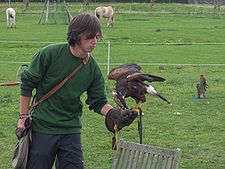
![]()
Parabuteo unicinctus is the sole representative of this genus worldwide. Arguably the best rabbit or hare raptor available anywhere, the Harris' Hawk is also practiced at catching birds. Often captive-bred, the Harris' Hawk is remarkably popular because of its temperament and ability. The Harris Hawk is plant in the wild living in groups or packs and hunts cooperatively, with a social hierarchy similar to wolves. This highly social behavior is not observed in whatever other bird of prey species and is very adaptable to falconry. This genus is native to the Americas from southern Texas and Arizona to northern South America.
Soaring hawks and the Mutual Buzzard (Buteo)
The genus Buteo, known as "hawks" in North America and not to be dislocated with vultures, has worldwide distribution but is particularly well represented in North America. The Ruby-red-tailed Hawk, Ferruginous Militarist, and rarely, the Red-shouldered Militarist are all examples of species from this genus that are used in falconry today. The Ruby-tailed Militarist is hardy and versatile, taking rabbits, hares, and squirrels; given the right weather condition information technology tin catch geese, ducks, pheasants, and even wild turkeys. The Cherry-Tailed Hawk is also considered a expert bird for beginners. The Eurasian or Common Buzzard is as well used, although this species requires more than perseverance if rabbits are to be hunted.
Truthful hawks (Accipiter)
The genus Accipiter is also found worldwide. The hawk expert Mike McDermott once said, "The attack of the accipiters is extremely swift, rapid and violent in every style." They are well known in falconry utilise both in Europe and North America. The Northern Goshawk has been trained for falconry for hundreds of years, taking a diverseness of birds and mammals. Other popular Accipiters used in falconry include: the Cooper's Hawk and Abrupt-shinned Militarist in Due north America and the European Sparrowhawk in Europe and Eurasia.
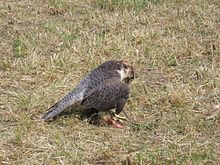
Falcons (Falco)
The genus Falco is plant worldwide and has occupied a primal niche in ancient and modern falconry. Most falcon species used in falconry are specialized predators, about adapted to capturing bird prey such every bit the Peregrine Falcon and Merlin. A notable exception is the use of desert falcons such the Saker Falcon in aboriginal and modernistic Eye Eastern and Asian falconry, where hares were and are normally taken. In North America, the Prairie Falcon and the Gyrfalcon tin can capture modest mammal prey (equally well as gamebirds and waterfowl) in falconry, but this is rarely practiced. Young falconers frequently begin practicing the fine art with American Kestrels, the smallest of the falcons in North America; at that place is argue on whether this practice should continue. [14]
Booted eagles (Aquila)
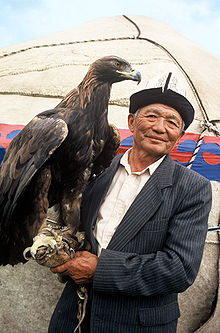
![]()
Eagle huntsman in Karakol, Kyrgyzstan
The Aquila (all have "booted" or feathered tarsus) genus has a nearly worldwide distribution. The more powerful types are used in falconry; for case Golden Eagles have reportedly been used to chase wolves [15] in Kazakhstan, and are at present used by the Kazakh hawkeye hunters to hunt foxes and other big prey, every bit they are in neighbouring Kyrgyzstan. [16] Most are primarily footing-oriented but will occasionally take birds. Eagles are not used equally widely in falconry as other birds of prey, due to the lack of versatility in the larger species (they primarily chase over large open up ground), the greater potential danger to other people if hunted in a widely populated area, and the difficulty of preparation and managing an eagle.
Owls (Strigidae)
Owls are not closely related to hawks or falcons. At that place is lilliputian written in classic falconry that discusses the use of Owls in falconry. However, at that place are at least two species that take successfully been used, the Eurasian Eagle Owl and the Bang-up Horned Owl. Successful preparation of owls is much different from the training of hawks and falcons, equally they are hearing- rather than sight-oriented (owls can just see blackness and white, and are long-sighted). This often leads falconers to believe that they are less intelligent, equally they are distracted easily by new or unnatural noises and they practice non answer as readily to nutrient cues. However, if trained successfully, owls show intelligence on the same level as that of hawks and falcons.
Osprey (Pandion)
The Osprey is a medium-large bird with a worldwide distribution that specializes in eating fish. More often than not speaking, it does not lend itself to falconry. Even so, the possibility of using a falcon to catch fish remains intriguing. (Some references to "ospreys" in onetime records mean a mechanical fish-communicable device and non the bird.)
Sea eagles (Haliaëtus)
Most species of genus Haliaëtus catch and eat fish, some almost exclusively. Still, in countries where they are non protected, some have been effectively used in hunting for ground quarry.
Species for beginners
In North America only the American Kestrel and the Crimson-tailed Hawk are permitted for a beginner falconer during his/her apprenticeship, except in Alaska, where the Northern Goshawk is allowed as information technology is much more abundant there than the Red-tailed Militarist. Opinions differ on the usefulness of the Kestrel for beginners due to its inherent fragility. In the United kingdom, beginner falconers are often permitted to acquire a larger variety of birds, but the Harris Hawk and Ruby-red-tailed Hawk remain the most commonly used for beginners and experienced falconers alike. [17] The Red-tailed Hawk is held in high regard in the Great britain due to the ease of breeding them in captivity, their inherent hardiness, and their capability hunting the rabbits and hares ordinarily found throughout the countryside in the Britain. Many falconers in the UK and Due north America switch to accipiters or large falcons post-obit their introduction with easier birds. In the United states accipiters, several types of buteos, and large falcons are just allowed to be owned by falconers who hold a general license. In that location are three kinds of falconry licenses in the United States, typically Apprentice course, General class, and Master class.
Husbandry, grooming, and equipment
Come across hack (falconry) and Falconry (preparation).
Falconry around the world
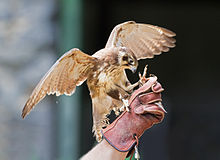
![]()
A Dark-brown Falcon used for falconry in Tasmania
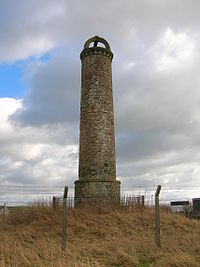
![]()
The Shaw Monument, a falconry ascertainment tower in Scotland.
Falconry is currently practiced in many countries around the world. The falconer's traditional choice of bird is the Northern Goshawk and Peregrine Falcon. In contemporary falconry in both North American and the Britain they remain popular, although the Harris Hawk and Blood-red-tailed Hawk are likely more widely used. The Northern Goshawk and the Aureate Eagle are more commonly used in Eastern Europe than elsewhere. In the Middle East, the Saker Falcon is the nearly traditional species flown against the Houbara Bustard, Sandgrouse, Stone-curlew, Hares, and other birds. Peregrines and other captively bred imported falcons are besides commonplace. Falconry remains an important part of the Arab heritage and civilization. The UAE reportedly spends over 27 million dollars annually towards the protection and conservation of wild falcons, and has gear up several state-of-the-art falcon hospitals in Dubai and Abu Dhabi. [18] There are two breeding farms in the Emirates, as well as those in Qatar and Saudi arabia. Every year, falcon beauty contests and demonstrations have place at the ADIHEX exhibition in Abu Dhabi.
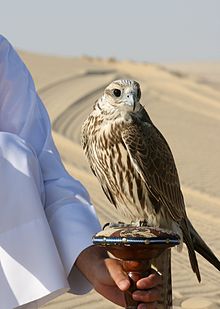
![]()
A Saker Falcon used for falconry in Qatar
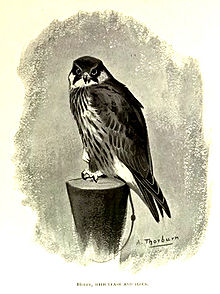
![]()
A Hobby
Sparrowhawks were formerly used to take a range of small birds, but are really too frail for serious falconry and have fallen out of favour now that American species are available.
In North America and the UK, falcons ordinarily fly only later on birds. Large falcons are typically trained to fly in the "waiting-on" style, where the falcon climbs and circles in a higher place the falconer and/or canis familiaris and the quarry is flushed when the falcon is in the desired commanding position. Classical game hawking in the UK saw a brace of peregrine falcons flown confronting the scarlet grouse, or merlins in "ringing" flights later skylarks. Rooks and crows are classic game for the larger falcons, and the magpie, making up in cunning what it lacks in flying power, is another mutual target. Short-wings can exist flown in both open up and wooded country against a variety of bird and small mammal prey. Most hunting with large falcons requires big open tracts where the falcon is afforded opportunity to strike or seize its quarry before information technology reaches embrace. Most of Europe practices similar styles of falconry, but with differing degrees of regulation.
Medieval falconers often rode horses but this is now rare with the exception of contemporary Kazakh and Mongolian falconry. In Kazakhstan, Kyrgyzstan, and Mongolia, the gilt eagle is traditionally flown (often from horseback), hunting game as big as foxes and wolves. [19]
Republic of korea allows a tiny number of people (a national total of iv in 2005) to own raptors and do falconry as a cultural asset.[ citation needed ]
In Japan, the Northern Goshawk has been used for centuries. Japan continues to accolade its strong historical links with falconry (Takagari) while adopting some modern techniques and technologies.
In Australia, although falconry is not specifically illegal, it is illegal to proceed whatever type of bird of prey in captivity without the appropriate permits. The simply exemption is when the birds are kept for purposes of rehabilitation (for which a licence must still be held), and in such circumstances it may be possible for a competent falconer to teach a bird to chase and impale wild quarry, as part of its regime of rehabilitation to skillful health and a fit state to be released into the wild.
South Africa has about 180 agile falconers. [20]
Tangent aspects, such as bird abatement and raptor rehabilitation too employ falconry techniques to accomplish their goals, but are not falconry in the proper sense of the word.
Clubs and organizations
In the UK the British Falconers' Social club is the oldest and largest of the falconry clubs. Working closely with the Militarist Board, an informational body representing the interests of United kingdom of great britain and northern ireland bird of prey keepers, the BFC is in the forefront of raptor conservation, falconer education and sustainable falconry. Established in 1927 the BFC now has a membership of over 1200 falconers. Information technology began equally a small and aristocracy guild, however it is now a sizeable autonomous organization that has members from all walks of life flying hawks, falcons and eagles at legal quarry throughout the British Isles.
The North American Falconers' Association (NAFA), founded in 1961, is the premier club for falconry in the US, Canada and Mexico, and has members worldwide. See Due north American Falconers Clan. NAFA is the principal gild in the The states and has a membership from around the world. NAFEX is the primary falconry forum for the United States and North America. Most USA states accept their own falconry clubs. Although these clubs are primarily social, they also serve to represent falconers within the state in regards to that country's wildlife regulations.
The IAF - International Association for Falconry and Conservation of Birds of Prey, founded in 1968, is currently representing 75 falconry clubs and conservation organisations from l countries worldwide totalling over thirty,000 members.
Captive breeding and conservation
The successful and now widespread convict breeding of birds of casualty began as a response to dwindling wild populations due to persistent toxins such as PCBs and Ddt, systematic persecution as indesirable predators, habitat loss, and the resulting limited availability of popular species for falconry, particularly the peregrine falcon. The beginning known raptors to brood in captivity belonged to a German falconer named Renz Waller. In 1942-1943 he produced ii young peregrines in Düsseldorf in Germany.
The first successful captive breeding of peregrine falcons in North America occurred in the early 1970s by The Peregrine Fund, Professor and falconer Heinz Meng, and other private falconer/breeders such as Dave Jamiesson and Les Boyd who bred the first peregrines past means of artificial insemination. In Great Great britain, falconer Phillip Glasier of the Falconry Centre in Newent, Gloucestershire, was successful in obtaining young from more than than 20 species of captive raptors. A cooperative effort began between various government agencies, non-government organizations, and falconers to supplement various wild raptor populations in peril. This endeavor was strongest in North America where pregnant individual donations along with funding allocations through the Endangered Species Human action of 1972 provided the means to continue the release of convict-bred Peregrines, Golden Eagles, Baldheaded Eagles, Aplomado Falcons and others. By the mid-1980s, falconers had become cocky-sufficient as regards sources of birds to train and wing, in addition to the immensely important conservation benefits conferred by captive breeding.
Until recently[ when? ], nearly all Peregrines used for falconry in the U.S. were captive-bred from the progeny of falcons taken before the U. S. Endangered Species Human action was enacted and from those few infusions of wild genes available from Canada and special circumstances. Peregrine Falcons were removed from the U.s.' endangered species list in 1999 due largely to the endeavor and knowledge of falconers in collaboration with the Peregrine Fund and state and federal agencies - through a technique called hacking.[ citation needed ] Finally, after years of close piece of work with the US Fish and Wildlife Service, a express take of wild Peregrines was allowed in 2004, the showtime wild Peregrines taken specifically for falconry in over thirty years.
Some controversy has existed over the origins of captive convenance stock used past The Peregrine Fund in the recovery of peregrine falcons throughout the contiguous Usa. Several peregrine subspecies were included in the breeding stock, including birds of Eurasian origin. Due to the extirpation of the Eastern anatum (Falco peregrinus anatum), the well-nigh extirpation of the anatum in the Midwest, and the limited genetic pool within North American breeding stock, the inclusion of non-native subspecies was justified to optimize the genetic diversity constitute within the species as a whole. [21] Such strategies are common in endangered species re-introduction scenarios, where dramatic population declines outcome in a genetic bottleneck and the loss of genetic diversity.
Laws regulating the capture and import/export of wild falcons throughout the Middle Eastward and Asia vary, and the effective enforcement of existing national and international regulations are defective in some regions. The proliferation of captive-bred falcons into the falcon markets of the Arabian Peninsula has likely moderated this need for wild falcons.
Hybrid falcons
The species within the genus Falco are closely related and some pairings produce viable offspring. The heavy northern Gyrfalcon and Asiatic Saker being especially closely related, and it is not known whether the Altai Falcon is a subspecies of the Saker or descendants of naturally occurring hybrids. Peregrine and prairie falcons accept been observed breeding in the wild and have produced offspring. [22] These pairings are thought to be rare, nevertheless extra-pair copulations between closely related species may occur more than ofttimes and/or account for most natural occurring hybridization. Some male first generation hybrids may take viable sperm, whereas very few starting time generation female hybrids lay fertile eggs. Because of these factors, naturally occurring hybridization is thought to be somewhat insignificant to factor flow in raptor species.
The starting time hybrid falcons produced in captivity occurred in western Ireland when veteran falconer Ronald Stevens and the Hon. John Morris put a male saker and a female peregrine into the same moulting mews for the spring and early summer, and the two mated and produced offspring.
Captively bred hybrid falcons have been bachelor since the late 1970s, and enjoyed a meteoric rise in popularity in Due north America and the Great britain in the 1990s. Hybrids were initially "created" to combine the horizontal speed and size of the gyrfalcon with the good disposition and aerial power of the peregrine. Hybrid falcons first gained big popularity throughout the Arabian Peninsula, feeding a demand for specially large and aggressive female falcons capable and willing to take on the very large Houbara Bustard, the classic falconry quarry in the deserts of the Middle East. These falcons were also very popular with Arab falconers as they tended to withstand a respiratory illness (aspergillosis from the mold strain aspergillus) in stressful desert conditions meliorate than other pure species from the northern hemisphere.
The Gyr/Peregrine hybrid is bred to combine the horizontal speed and size of the gyrfalcon with the adept disposition and aerial nature of a peregrine. Such hybrids accept go popular among falconers worldwide.
Bogus option and domestication
Some believe that no species of raptor have been in captivity long enough to have undergone successful selective breeding for desired traits. Captive breeding of raptors over several generations tends to result, either deliberately, or inevitably as a issue of captivity, in selection for certain traits, including:
- Ability to survive in captivity.
- Ability to breed in captivity.
- (In most cases) suitability for interactions with humans for falconry. Birds which demonstrated an unwillingness to hunt with men were most often discarded, rather than being placed in breeding projects.
- With gyrfalcons in areas away from their natural Arctic tundra habitat, meliorate disease resistance.
- With gyrfalcons, feather colour [2].
Escaped falconry birds
Falconers' birds are inevitably lost on occasion, though most are found again. The main reason birds can be plant again is considering, during complimentary flights, birds usually vesture radio transmitters or bells. The transmitters are in the middle of the tail, on the back, or attached to the bird'southward legs.
Records of species becoming established in Britain after escaping or being released include:
- Escaped Harris hawks reportedly breed in the wild in Britain.
- The return of the Goshawk as a breeding bird to United kingdom since 1945 is due in large part to falconers' escapes: the earlier British population was wiped out by gamekeepers and egg collectors in the late 19th and early 20th centuries.
- A pair of European Eagle Owls bred in the wild in Yorkshire for several years, feeding largely or entirely on rabbits. The pair are virtually likely convict escapees. It is not notwithstanding known if this will pb to a population condign established.
- In 1986, a lost captive-bred female person prairie falcon (which had been cross-fostered by an adult peregrine in captivity) mated with a wild male peregrine in Utah. The prairie falcon was trapped and the eggs removed, incubated, hatched and the hybrid offspring were given to falconers. The wild peregrine paired with another peregrine the adjacent twelvemonth.
- Falconry in Hawaii is prohibited largely due to the fears of escaped non-native birds of prey becoming established on the island chain and aggravating an already rampant problem of invasive species impacts on native widlife and establish communities.
Regulations in Great Britain
In sharp contrast to the Usa, falconry in Peachy Britain is permitted without a special license. However, a restriction exists of using merely captive-bred birds. In the lengthy, record-breaking debates in Westminster during the passage of the 1981 Wildlife & Countryside Nib, efforts were made by the Purple Society for the Protection of Birds and other lobby groups to have falconry outlawed, but these were successfully resisted. After a centuries-former just informal existence in United kingdom of great britain and northern ireland, the sport of falconry was finally given formal legal status in Corking Uk past the Wildlife and Countryside Act 1981, which allowed it to continue provided all convict raptors native to the U.k. were officially ringed and government-registered. Deoxyribonucleic acid-testing was also bachelor to verify birds' origins. Since 1982 the British government's licensing requirements take been overseen by the Chief Wildlife Act Inspector for Great Uk, who is assisted past a panel of unpaid assistant inspectors.
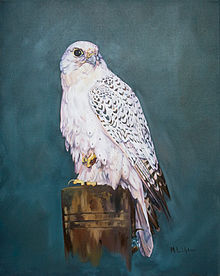
![]()
A White Gyr
British falconers are entirely reliant upon captive-bred birds for their sport. The taking of raptors from the wild for falconry, although permitted by constabulary under government licence, has not been allowed in contempo decades.
Anyone is permitted to possess legally registered or captive-bred raptors, although falconers are anxious to point out that this is non synonymous with falconry, which specifically entails the hunting of live quarry with a trained bird. A raptor kept merely as a pet or possession, although the law may allow it, is not considered to be a falconer's bird. Birds may be used for convenance or kept after their hunting days are over, but falconers believe information technology is preferable that young, fit birds are flown at quarry.
Regulations in the U.S
In the United states of america, falconry is legal in all states except Hawaii. It is also illegal in the District of Columbia. A falconer must accept country and federal licenses to practice the sport. Acquiring a falconry license in the The states requires an aspiring falconer to pass a written exam, have equipment and facilities inspected, and serve a minimum of two years every bit an apprentice nether a licensed falconer. At that place are three classes of the falconry license, which is a permit issued jointly by the falconer'southward land of residence and the federal government. The aforementioned Apprentice license matriculates to a General Class license, which allows the falconer to possess no more than 2 raptors at a time. Subsequently a minimum of 5 years at Full general level, falconers may utilize for a Master Class license, which allows them to keep 3 raptors for falconry.
Within the U.South., a state'south regulations may be more, simply not less, restrictive than the federal guidelines. Both land and federal regulations (besides as state hunting laws) must be complied with by the falconer. Most states afford falconers an extended hunting flavour relative to seasons for archery and firearms, however species to be hunted, bag limits, and possession limits remain the same for both. No extended seasons for falconry be for the hunting of migratory birds such every bit waterfowl and doves.
Federal regulation of falconry in North America is enforced nether the statutes of the Migratory Bird Treaty Act of 1918 (MBTA), originally designed to address the rampant commercial marketplace hunting of migratory waterbirds during the early on 20th century. Birds of prey suffered extreme persecution from the early on 1900s through the 1960s, where thousands of birds where shot at conspicuous migration sites and many land widlife agencies issued bounties for carcasses. [23] Due to widespread persecution and further impacts to raptor populations from DDT and other toxins, the human action was amended in 1972 to include birds of prey (eagles are also protected under the Bald and Gilded Eagle Protection Act of 1959). Under the MBTA, it is illegal for people to "have" migratory birds, their eggs, feathers or nests. Accept is divers in the MBTA to "include by any means or in any style, any attempt at hunting, pursuing, wounding, killing, possessing or transporting whatever migratory bird, nest, egg, or role thereof". [24] Falconers are allowed to trap, and otherwise possess certain birds of prey and their feathers with special permits issued by the Migratory Bird Office of the U.S. Fish and Wild fauna Service and past state wildlife agencies (issuers of trapping permits).
The Convention on International Merchandise on Endangered Species of Wild Flora and Animate being (CITES) restricts the import and export of most native birds species and are listed in the CITES Appendix I, Two, & III.
The Wild Bird Conservation Act (WBCA), legislation put into effect circa 1993, regulates importation of any CITES-listed birds into the Us.
Some controversy exists over the outcome of falconer's ownership of captively bred birds of casualty. Falconry permits are issued by the U.Due south. Fish & Wild fauna Service in a manner that entrusts falconers to "accept" (trap) and possess permitted birds and apply them only for permitted activities, simply does not transfer legal ownership. No legal distinction is made between native wild trapped vs. captive bred birds of the same species. This legal position is designed to disincentivize the commercial exploitation of native wildlife.
Falconry today
Falcons tin can alive into their mid teens, with larger hawks living longer and eagles likely to run across out heart-aged owners. Through the captive convenance of rescued birds, the final xxx years have seen a great rebirth of the sport, with a host of innovations; falconry'south popularity, through lure flight displays at country houses and game fairs, has probably never been higher in the by 300 years. Ornithologist Tim Gallagher, editor of the Cornell Lab of Ornithology'south Living Bird mag, documented his experiences with modern falconry in a 2008 volume, Falcon Fever. [25]
Making use of the natural relationship between raptors and their prey, today, falconry is used to control pest birds and animals in urban areas, landfills, commercial buildings, and airports. Falconer Dan Frankian of Eagle Bird and Animal Control oft speaks on the subject field to news crews while his hawks and falcons are flying over Toronto City Hall, in an effort to control the city's gull and pigeon population.
Falconry Centres or Birds of Prey Centres house these raptors. They are responsible for many aspects of Bird of Prey Conservation (through keeping the birds for pedagogy and breeding). Many comport regular flying demonstrations and educational talks, and are popular with visitors worldwide.
Such centres may also provide Falconry Courses, Hawk Walks, Displays and other experiences with these raptors - see links at bottom of folio for details.
Literature and film
- In the ninth novel of the 5th mean solar day of Giovanni Boccaccio's The Decameron, a medieval collection of novellas, a falcon is central to the plot: The nobleman Federigo degli Alberighi has wasted his fortune courting his unrequited dear until cypher is left but his dauntless falcon. When his lady come up to see him he gives her the falcon to eat. Knowing his example she changes her heed, takes him to husband and makes him rich.
- In Virginia Henley'southward historical romance books, "The Falcon and the Flower", "The Dragon and the Jewel", "The Spousal relationship Prize", "The Border Hostage" and "Infamous", at that place are numerous mentions to the fine art of falconry, equally these books are set at dates ranging from the 1150s to the 16th century.
- The main character, Sam Gribley, in the children'due south novel "My Side of the Mountain" is a falconer. His trained falcon is named Frightful.
- In the book and flick The Falcon and the Snowman about two Americans who sold secrets to the Soviets, one of the two principal characters, Christopher Boyce, is a falconer.
- In The Purple Tenenbaums, Richie keeps a falcon named Mordecai on the roof of his domicile in Brooklyn.
- In James Clavell'due south Shogun, Toranaga, one of the chief characters, practices falconry throughout the volume, often during or immediately before or after important plot events. His thoughts also reveal analogy between his falconry and his apply of other characters towards his ends.
- The 1985 film Ladyhawke involved a medieval warrior who carried a red tail hawk as a pet, just in truth, the hawk was actually his lover who had been cursed by an evil bishop to go on the two apart.
- In The Nighttime Belfry series, the chief character, Roland, uses a hawk named David, to win a trial by combat in order to get a Gunslinger.
- "The Falconer" is a recurring sketch on Sat Dark Alive, featuring Volition Forte as a falconer who constantly finds himself in mortal peril and must rely on his loyal falcon, Donald, to rescue him.
- Gabriel García Márquez's novel Chronicle of a Expiry Foretold's main character, Santiago Nasar, and his father are falconers.
- Hodgesaargh is a falconer based in Lancre Castle in Terry Pratchetts Discworld book. He is an skillful and dedicated falconer who unluckily seems to only go on birds that relish attacking him.
- Fantasy author Mercedes Lackey is a falconer and oftentimes adds birds of prey to her novels. Amongst the Tayledras or Hawkbrother race in her Chronicles of Valdemar, everyone bonds with a peculiarly bred raptor called a bondbird which has limited powers of speech communication mind-to-mind and can scout and hunt for its human bondmate.
- In the video game series "Samurai Shodown", one of the main characters is Nakoruru, an Ainu priestess who besides fights using falconry, with her militarist, Mamahaha
- Crime novelist Andy Straka is a falconer and his Frank Pavlicek individual middle serial features a former NYPD homicide detective and falconer as protagonist. The books include A Witness Above, A Killing Sky, Cold Quarry (2001, 2002, 2003), and Kitty Hitter (2009).
- In Irish Poet William Butler Yeats'south poem, "The 2d Coming", Yeats uses the image of, "The falcon cannot hear the falconer" as a metaphor for social disintegration.
- American Poet Robert Duncan's poem, "My Mother Would Be a Falconress" [26]
- The comic book Gold Band by Qais M. Sedki and Akira Himekawa features falconers and falcons
English idioms derived from falconry
These English linguistic communication idioms are derived from falconry:
| Expression | Meaning in falconry | Derived pregnant |
|---|---|---|
| in a bate | bating: trying to fly off when tethered | in a panic |
| fed up | of a hawk, with its crop full and then non wanting to hunt | no longer interested in something |
| haggard | of a hawk, caught from the wild when developed | looking exhausted and unwell, in poor condition; wild or untamed |
| nether his/her thumb | of the militarist's ternion when secured to the fist | tightly nether control |
| wrapped circular his/her piffling finger | of the hawk'south leash when secured to the fist | tightly nether control |
Run into besides
- Animal training
- Hunting
- Anti-hunting
- Hunting dog
- Takagari
- Falconry training and technique
- Parahawking
- Falconer'south knot
- Hack (falconry)
References
- ^ North American Falconers Association, http://www.due north-a-f-a.com/AboutFalconry.htm
- ^ a b Bert, Due east. 1619. An Approved Treatise on Hawks and Hawking
- ^ a b Latham, S. 1633. The Falcon's Lure and Cure
- ^ Strutt, Joseph (1801). J. Charles Cox. ed. The sports and pastimes of the people of England from the earliest menses. Methuen & co.. p. 24. http://books.google.com/books?id=eJwSAAAAYAAJ&pg=PA24 . Retrieved June half dozen, 2009.
- ^ Epic of Gilgamesh
- ^ Layard, A. H. (1853). Discoveries in the Ruins of Nineveh and Babylon. London: John Murray.
- ^ Egerton, F. 2003. A History of the Ecological Sciences, Part 8: Fredrick Ii of Hohenstaufen: Apprentice Avian Ecologist and Behaviorist. Bulletin of the Ecological Social club of America. 84(1):40–44. [1]
- ^ Ferber, S. 1979 Islam and The Midieval W
- ^ Thesiger, Westward. 1959. Arabian Sands. Penguin Books
- ^ Mitchell, East.B. 1900. (7th ed.1971.) Charles T. Branford Co., Newton, MA. 291pg.
- ^ A cursory history of North American Falconry http://world wide web.n-a-f-a.com/General_History.htm
- ^ page xi, issue #36, Austringer periodical, published by The Welsh Hawking Club
- ^ Falconry, an illustrated introduction, by Humphrey ap Evans, first published 1973 past John Bartholomew & Son Ltd, ISBN 0 85152 921 6
- ^ http://www.americanfalconry.com/appKestrels.html
- ^ The last Wolf Bell-ringer: The Eagle Falconry of Friedrich Remmler by Martin Hollinshead, The Fernhill Press 2006
- ^ Kyrgyzstan past Rowan Stewart, p182, Odyssey 2002
- ^ http://users.cybercity.dk/~ccc12787/raptors/parabuteo.html
- ^ http://uaeinteract.com/news/default.asp?ID=72
- ^ http://www.avmv20.dsl.pipex.com/Photo%20Album/Kyrgyzstan/Ishpays%20eagle.htm
- ^ "S African Falconry History.". South African Falconry Association. http://www.safa.za.net/falconry-in-history/sa-falconry-history/ . Retrieved 2010-01-09.
- ^ Cade, T.J., Burnham W. 2003 The Return of the Peregrine:a Northward American sage of tenacity and teamwork. The Peregrine Fund
- ^ Oliphant, L.West. 1991 The Journal of Raptor Inquiry. 25 (ii): 36-39
- ^ Matthiessen, P. 1959 Wildlife in America. Viking Press
- ^ US Department of the Interior, USFWS http://world wide web.fws.gov/pacific/migratorybirds/mbta.htm
- ^ At the moment there are about 5,000 falconers effectually the United states. "WildBird on the Wing: Tim Gallagher'south got "Falcon Fever"". wildbirdonthefly.blogspot.com. http://wildbirdonthefly.blogspot.com/2008/05/tim-gallaghers-got-falcon-fever.html . Retrieved 2009-04-11.
- ^ http://world wide web.poets.org/viewmedia.php/prmMID/15709
Further reading
- Modern Apprentice: Site for North Americans interested in falconry past Lydia Ash. (Much information for this entry was due to her enquiry)
- Beatriz E. Candil García, Arjen East.Hartman, Ars Accipitraria: An Essential Lexicon for the Practice of Falconry and hawking"; Yarak Publishing, London, 2007, ISBN 978-0-9555607-0-v (The excerpt on the language of falconry comes from this book)
- Beatriz Due east. Candil García, The Cherry-red-tailed Hawk: The Great Unknown Yarak London, 2008, ISBN 978-0-9555607-four-3
- F.L. Beebe, H.Yard. Webster, North American Falconry and Hunting Hawks; 8th edition, 2000, ISBN 0-685-66290-Ten,
External links
- Falconry Articles
- International Falconry Forum .com
- Falconry Forum
- Falconry at the Open Directory Projection
- Medieval Hawking Whistle
Source: https://en-academic.com/dic.nsf/enwiki/114675
0 Response to "The Art and Practice of Hawking E B Mitchell Ct Branford Co Newton Mass"
Post a Comment